Introduction
Ginkgoes as “Living Fossils”
Ginkgoes in the Urban Forest
Acknowledgements and References
In the heart of Lafayette Park, visitors are drawn to a dramatic equestrian statue that has the White House as a backdrop:
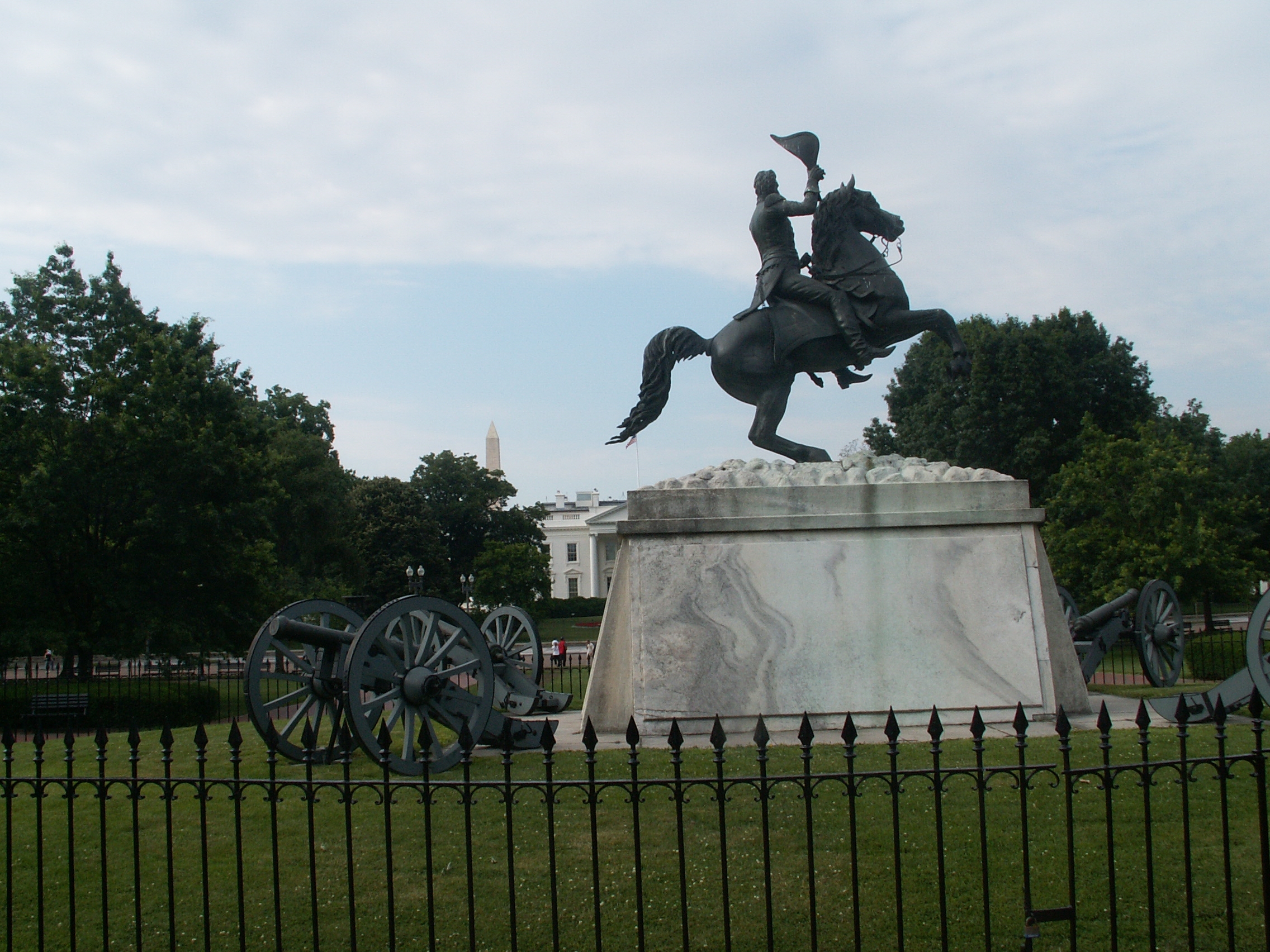
Cast in 1854, the statue portrays General Andrew Jackson reviewing his troops on the day of the Battle of New Orleans. Jackson’s rearing horse stands on a pediment of “Tennessee Marble.” Having a close look at the stone would be impossible – it is enclosed within an iron security fence – and is unnecessary for fossil hunting purposes. There appear to be no visible fossils in the pediment, or in the pediments to the other four major monuments at the park’s corners, nor in stones anywhere else in the park
A large fossil does stand nearby, however. Note the tree growing just beyond the northwest corner of the plaza surrounding Jackson’s statute:
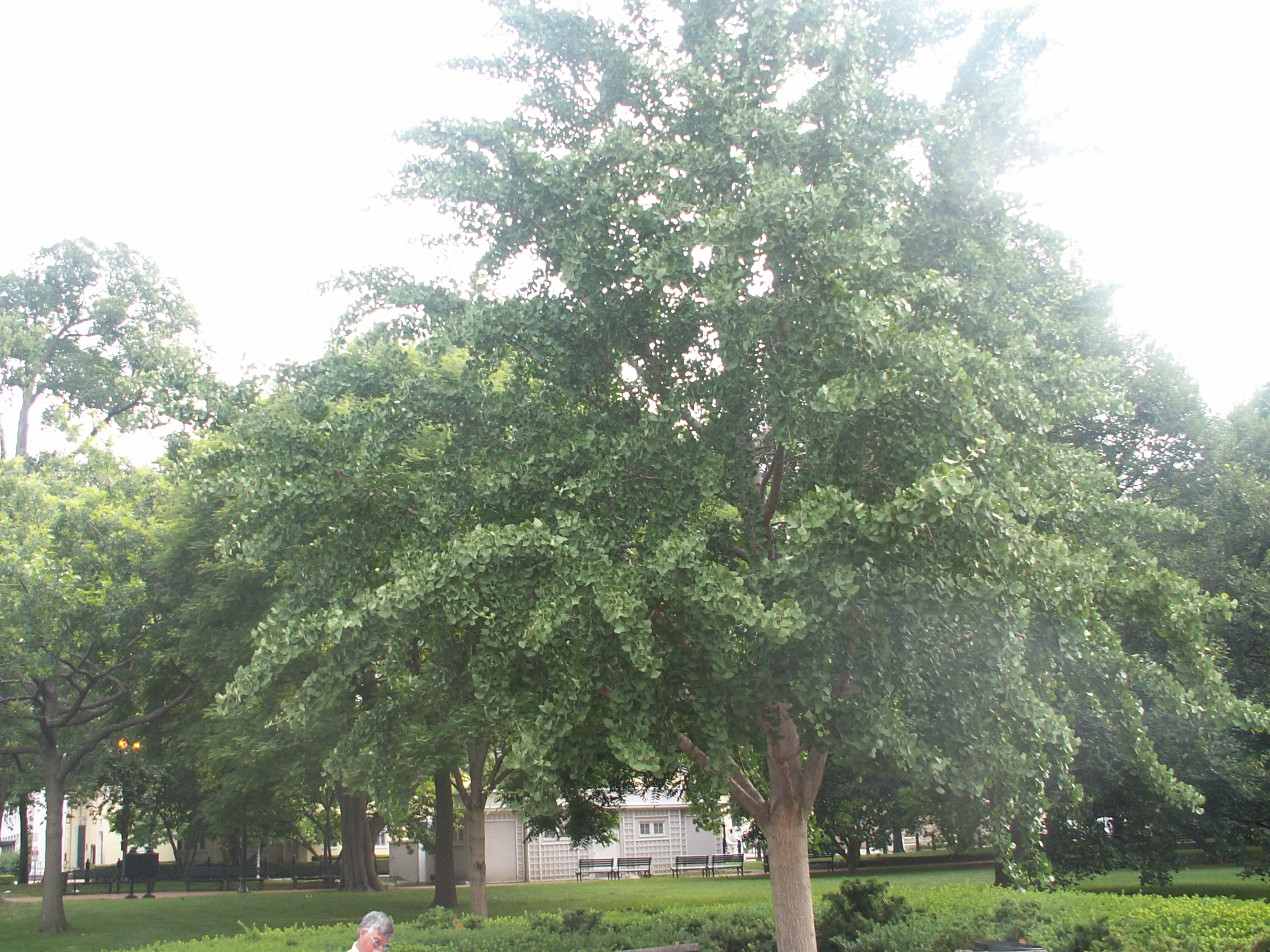
It is a gingko tree — Ginkgo biloba. Superficially, it resembles many other urban shade trees in the park. It is, however, a “living fossil” that closely resembles ginkgo species that lived more than 100 million years ago. Today, only one ginkgo species remains of its entire ancient order. After becoming extinct elsewhere in the world, gingkoes survived in China chiefly in temple grounds and gardens, until they radiated outward worldwide through human intervention during historical times.
The ginkgo tree in Lafayette Square is not alone. Ginkgoes line the western side of the Square. Nearby Farragut Square and McPherson Square each host a large, mature ginkgo. Ginkgoes are heavily planted in the downtown area bordered by E St., 11th St., K St. and 14th St., as well as the busy heart of Adams Morgan, along 18th St., N.W. Citywide, ginkgoes are the fifth most common type of street tree, according to a recent Casey Trees Foundation survey.
Unlike the mineral fossils built into the city, “living fossils” are not the physical remains of living things from the distant past. They deserve attention nonetheless in the city’s Accidental Museum of Paleontology. Every day and in every quadrant of the city, countless pedestrians hurry under the branches of trees very much like those that shaded the dinosaurs. This website would be incomplete without a brief account of their remarkable history, nature and survival.
Ginkgoes first emerged in the early Jurassic, approximately 190 million years ago and may have evolved from now-extinct seed ferns. They are a variety of gymnosperm related to conifers. Ginkgoes flourished in variety and geographical dispersion through the middle Mesozoic, reaching their peak during the Cretaceous.
The “living fossil” tag stems from the remarkable resemblance between long-extinct ginkgoes and modern ones. Observe the image below of a fossil Ginkgo Digitata, from the late Cretaceous of Alaska:
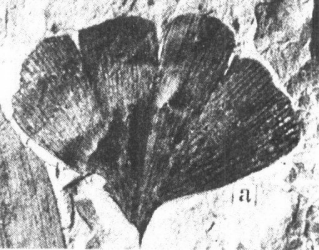
Compare that image to a photograph of a modern ginkgo leaf in the District:
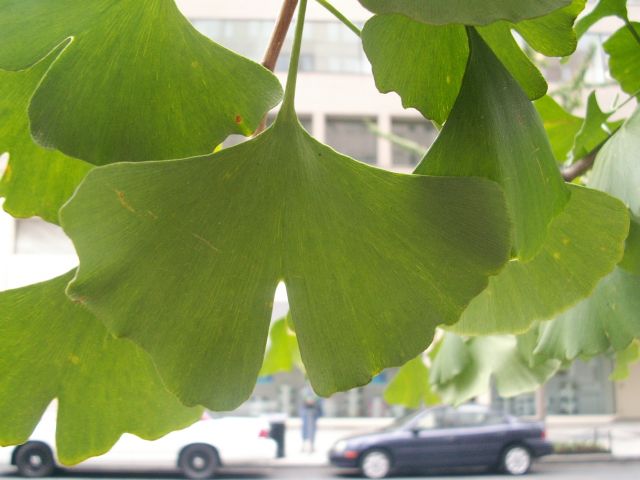
The modern ginkgo differs in having two lobes in each leaf (hence, Ginkgo Biloba ”two lobes”), but individual leaves of a single ginkgo tree will vary considerably in appearance, often not showing any division into lobes, or suggesting four lobes; note the difference between the photograph above and the modern leaf shown below:
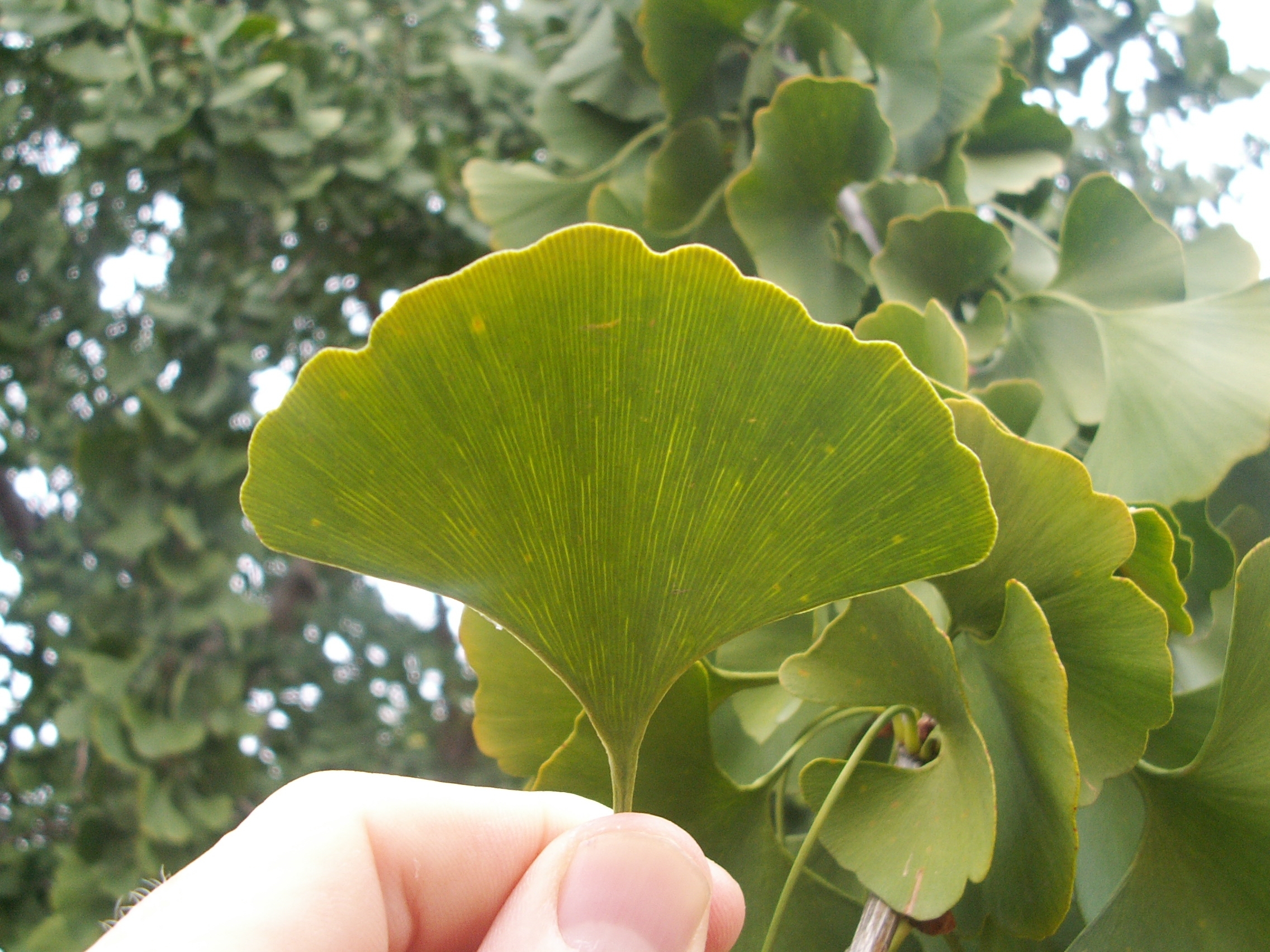
By the Paleocene period, ginkgoes were reduced in diversity and range to northern regions. In North America, they became extinct 7 million years ago in response to a cooling and drying of the climate.
After disappearing from North America and Europe, ginkgoes survived into historical times in China. Sung Dynasty writings refer to them as being native to eastern China. From approximately 1100 A.D., ginkgoes appear to have been propagated throughout China and were valued in particular for their nut (which is not to be confused with the noxious surrounding fruit, which is discussed below). In addition to other cultivation, ginkgoes were planted on the grounds of Buddhist monasteries, and in palaces and temples, eventually reaching Japan and Korea. Europeans became familiar with ginkgoes through Engelbert Kaempfer of the Dutch East India Company, who brought seeds from Japan early in the 1700s. Ginkgoes were first planted in America in the late 1700s, and became popular as a street tree late in the 1800s.
In 2004, the Casey Trees Endowment Fund performed an inventory of D.C.’s street trees. The survey found approximately 106,000 street trees, with the most popular four types of tree genus being maple, oak, elm and linden. The fifth most common genus was the ginkgo, 4,330 trees strong — outnumbering cherry trees and sycamores. Ginkgoes are found all over the city, as the maps prepared by the Casey Trees Endowment Fund show. Find the ginkgoes near your street! See http://www.caseytrees.org/treemap/index.html (interactive tree map providing identification and information regarding every street tree in the city, by geographic location).
Why is the ginkgo so popular?
Gingkoes have several advantages as urban street trees.
- They are resistant to pollution and pests; a major advantage in the often stressful city environment.
- They can grow in any temperate or Mediterranean climate.
- And they provide a striking and attractive visual accent.
Ginkgoes can grow more than 100 feet high, although they usually reach 60 to 80 feet. They can live for well over 1,000 years. They have green, fan-shaped leaves in the warm months (one Japanese word for ginkgo is “tree with leaves like a duck’s foot”). In the fall, their leaves are bright yellow:
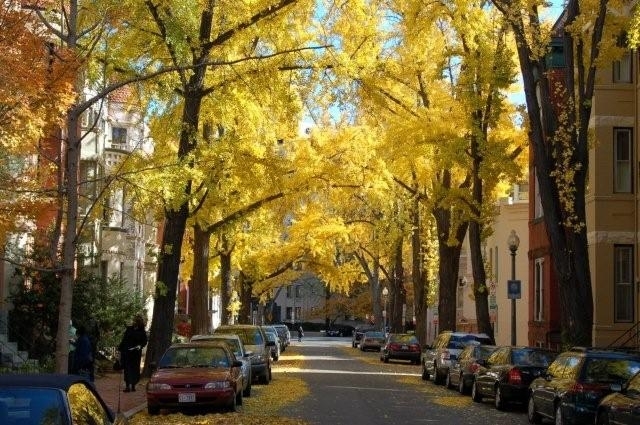
(Photograph, ginkgoes lining Riggs Place, N.W., fall 2007, by and courtesy of Bill Baker, Washington, D.C.)
Not everyone agrees that ginkgoes are appropriate for city streets. An Ohio State University website on useful trees describes the ginkgo as “sometimes incorrectly used as a street tree due to its extreme urban tolerance, but much too big (even in stunted and columnar cultivar form) for this usage.”
That criticism fails even to mention the tree’s most notorious feature for many Washingtonians: the smell of the female ginkgo tree’s fruit. After describing the smell as potentially “overpowering,” one source has collected quotations from the horticultural literature, which describe the odor as follows: “ ‘disagreeable,’ ‘evil,’ ‘offensive,’ ‘disgusting,’ repulsive,’ and ‘abominable,’ and is often compared to the odor of vomit.” The cause is the presence of butyric acid in the skin of the seed – the same chemical that creates the smell of rancid butter.
As a result, the District of Columbia’s Urban Forestry Administration offers two unusual services: springtime spraying to halt fruit development, and, for extremely unpopular ginkgoes, the application of its “Female Ginkgo Tree Removal Policy.” (There are male and female ginkgo trees, and only the female trees bear the contentious fruit.)
It would be most unfortunate, however, if the only association made by many residents and visitors with the ginkgo tree were the sometimes unpleasant smell of its fruits.
They should also visualize these neighborhood trees as the trees might have been back in the Cretaceous – providing a perch for the Archaeopteryx, or shade for dinosaurs. The artist John Agnew created a Mesozoic mural for the bird exhibit of Riverbanks Zoo in Columbia, South Carolina, showing extinct primitive birds and their ancestors (Coelophysis from the Triassic, Deinonychus from the Jurassic and an Oviraptor and young from the Cretaceous) – and of course, Archeopteryx. Dominating the center of this Mesozoic mural is a gingko:
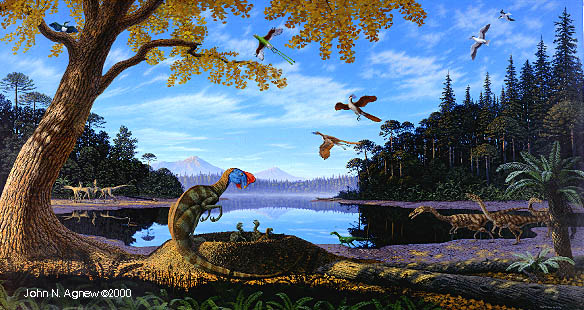
(This image is reproduced with the permission of the artist, John Agnew and Riverbanks Zoo, Columbia, South Carolina, where the mural appears.)
Residents should also reflect on the thoughts about the ginkgo written by the paleobotanist, Sir Albert Seward in 1938:
It appeals to the historic soul; we see it as an emblem of changelessness, a heritage from worlds too remote for our human intelligence to grasp, a tree which has in its keeping the secrets of the immeasurable past.
Hopefully, residents will treasure the city’s ginkgoes for both their good characteristics and their wonderfully evocative past.
Acknowledgments and Sources[1]
Origins, development and fossil record of ginkgoes.
Encyclopedia of Paleontology, Vol. 1, Ronald Singer (ed.) (Fitzroy Dearborn Publishers 1999) at pp. 517-522.
The Fossil Book, Fenton and Fenton (Doubleday 1989 ed.) at 389.
“Introduction to the Ginkgoales,” at http://www.ucmp.berkeley.edu/seedplants/ginkgoales/ginkgo.html,
Image of mesozoic ginkgo, credited to “Fairbanks 1947”.
Information about the history of the ginkgo, and much else, is also from the wonderfully comprehensive, entertaining and award-winning website by Cor Kwant, “The Ginkgo Pages,” at http://www.xs4all.nl/~kwanten/ Among other features of this astonishing resource, he has assembled a large number of pictures of fossil ginkgo leaves.
Ginkgo characteristics and use in the urban forest.
General comments on the features of the tree are found in the UC Berkeley website cited above, as well as in the Ohio State website, http://www.hcs.ohio-state.edu/hcs/TMI/Plantlist/gi_iloba.html, which is also the source of the quotation regarding the “incorrect” use of ginkgoes as a street tree.
The photograph of ginkgoes with fall foliage is provided by and with the generous permission of Bill Baker, Washington, D.C.
The D.C. tree inventory is set out in, The State of Our Trees: The Status and Health of the Street Trees of Washington, D.C., Preliminary Findings, Casey Trees Endowment Fund (2005).
The District’s female ginkgo services are described at http://www.ddot.dc.gov/ufa/cwp/view,a,1292,q,575305,ufaNav_GID,1631,ufaNav,|32697|.asp
The mural of the ginkgo and dinosaurs appears with permission of the artist, John Agnew and Riverbanks Zoo in Columbia, South Carolina. The artist describes his creation of this mural at http://www.angelfire.com/id/wildscenes/mural.html , which also provides more detail regarding the species shown in it.
The quotation by Sir Arthur Steward is from Cor Kwant’s “The Ginkgo Pages” website cited above.
[1] Where this website cites specific internet page addresses, they are typically the addresses used by the author in researching and writing this discussion – a process taking several years. Unfortunately, in the meantime a number of the specific addresses have changed, and will continue to change, rendering some of these addresses ineffective as links. Readers should be able to find the material by searching for the proper name of the cited article or material on a search engine.
